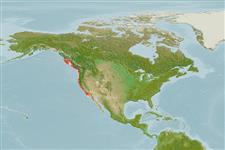>
Ovalentaria/misc (Various families in series Ovalentaria) >
Embiotocidae (Surfperches)
Etymology: Hyperprosopon: Greek, hyper = over + Greek, prosopon = face, snout of animal (Ref. 45335); ellipticum: From the Latin 'ellipticum' - referring to the outline of the body (Ref. 6885).
Environment: milieu / climate zone / depth range / distribution range
Ecología
marino demersal; rango de profundidad 0 - 110 m (Ref. 2850). Subtropical; 56°N - 30°N, 135°W - 116°W
Eastern Pacific: southern British Columbia, Canada to Rio San Vincente, northern Baja California, Mexico.
Tamaño / Peso / Age
Maturity: Lm ? range ? - ? cm
Max length : 27.0 cm TL macho / no sexado; (Ref. 2850); edad máxima reportada: 7 años (Ref. 56049)
Short description
Claves de identificación | Morfología | Morfometría
Espinas dorsales (total) : 8 - 10; Radios blandos dorsales (total) : 25 - 28; Espinas anales: 3; Radios blandos anales: 29 - 34. Dark green dorsally, sides and belly silvery; a series of narrow vertical bars of pale golden pink on body wall; pectoral fins colorless (Ref. 6885). British Columbia specimens dark on end of caudal fin and free edge of spinous dorsal (Ref. 6885).
Found inshore, in surf and sandy areas, also occur around rocks and piers (Ref. 2850). Intertidal and to 110 m (Ref. 96339). Viviparous, female carries the developing young (Ref. 205). Frequently caught, but not of much importance as a sport fish due to its small size (Ref. 2850).
Life cycle and mating behavior
Madurez | Reproducción | Puesta | Huevos | Fecundidad | Larva
Viviparous, female carries the developing young (Ref. 205).
Eschmeyer, W.N., E.S. Herald and H. Hammann, 1983. A field guide to Pacific coast fishes of North America. Boston (MA, USA): Houghton Mifflin Company. xii+336 p. (Ref. 2850)
IUCN Red List Status (Ref. 130435: Version 2024-2)
Threat to humans
Harmless
Human uses
Pesquerías: comercial; pesca deportiva: si; Acuario: Acuarios públicos
Herramientas
Special reports
Download XML
Fuentes de Internet
Estimates based on models
Preferred temperature (Ref.
123201): 8.3 - 12.8, mean 9.8 °C (based on 64 cells).
Phylogenetic diversity index (Ref.
82804): PD
50 = 0.6250 [Uniqueness, from 0.5 = low to 2.0 = high].
Bayesian length-weight: a=0.01905 (0.00827 - 0.04391), b=2.97 (2.77 - 3.17), in cm total length, based on LWR estimates for this (Sub)family-body shape (Ref.
93245).
Nivel trófico (Ref.
69278): 3.3 ±0.5 se; based on size and trophs of closest relatives
Resiliencia (Ref.
120179): Medio, población duplicada en un tiempo mínimo de 1.4-4.4 años (tm=3; tmax=7).
Fishing Vulnerability (Ref.
59153): Low vulnerability (17 of 100).
